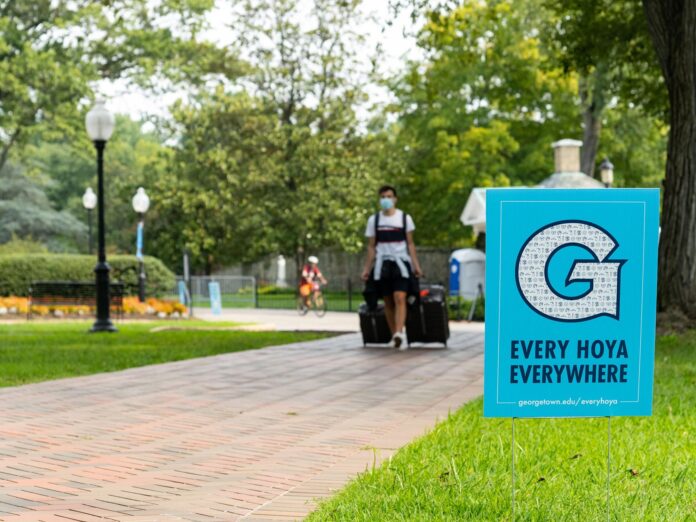The case for reopening Georgetown University does not involve advocating that any person associated with the D.C. community die. Georgetown can reopen safely with respect and security for all.
The economist Thomas Sowell famously said that in life, “There are no solutions. There are only trade-offs.” Any approach Georgetown takes for the spring will have tradeoffs. None of those tradeoffs include risks that we all do not take living our lives every day. None of those tradeoffs involve an unreasonable risk of death.
Safety
Georgetown University has the ability and financial resources to make sure that those who are immunocompromised receive the adequate resources to stay safe. Faculty and students who would feel unsafe returning to Georgetown should not be required to do so, and could maintain their virtual learning environment. Administrators could also virtually maintain their work. Georgetown reopening does not require putting any university employee into undue risk. Employees whose jobs require a lot of interpersonal interaction would have the choice to return, weighing the costs and benefits of in-person work. Georgetown would provide every possible protection to those employees.
Georgetown University has met the requirements to reopen safely. The positivity rate at Georgetown hovers around 0.3%, which is below the WHO-recommended 5% positivity rate needed for whole states to reopen. Hypothetically, in a school of approximately 7500, assuming a 0.3% positivity rate and a 0.02% mortality rate (for people 20-49), we would lose 0.0045 students. With the same positivity rate and a 0.003% mortality rate (for people 0-19), we would lose 0.000675 students.
In any other scenario—ones in which people’s mental health and academic and professional futures were not being held hostage—those numbers would round to zero.
Since numbers are numbers, regardless of narrative, those figures do round to zero, and it is reckless to use them as justification for continued and indefinite lockdown. Tragically, we lost hundreds of times that number of students last year in natural disasters and accidents, yet we do not ban students from travel or driving.
Georgetown University would not be an irresponsible institution if it chose to reopen. Universities of similar sizes and located in similar population densities have announced Fall 2020 or Spring 2021 reopening plans. These universities include Tufts, Villanova, Ohio State, and Johns Hopkins.
It is important to note again that outbreaks do not equal death. According to The New York Times, as of November 5, fewer than 90 people affiliated with universities have reportedly died of COVID out of 252,000 confirmed cases (a 0.357% mortality rate). These concrete numbers indicate a higher risk than the aforementioned hypotheticals, but it is important to note, “Most of the deaths were reported in the spring and involved college employees, not students [three students have reportedly died].”
The chance of dying of COVID on a university campus, regardless of age, with current reported numbers, is less than 1 in 2,800. For comparison, the probability of dying of an opioid overdose is 1 in 96. The chance of dying in a vehicle is 1 in 103.
College students who do not have comorbidities (who are the students who would be on campus should it reopen) are extremely resilient to the virus. According to The Washington Post, “18 states have not seen a single fatality among people under 20 as of September 10, according to statistics compiled by the American Academy of Pediatrics and the Children’s Hospital Association.” And again, students with comorbidities should be given the option to continue online learning.
The Costs of Keeping Students Home
Forcing students to remain at home comes with a bevy of risks, including domestic violence, drug abuse, depression, and poor academic performance.
Domestic Violence
According to the Council on Foreign Relations, “Data from many regions already suggests significant increases in domestic violence cases, particularly among marginalized populations.” Female and LGBTQ+ students are all at higher risks of domestic abuse, and Georgetown has a responsibility to protect them.
Drug Abuse
During the lockdowns, and due to stress over the state of the world, opioid-related deaths have risen, especially in marginalized communities. Alcohol use is also up, which can worsen the already-large mental health strain (depression, anxiety, etc.) these lockdowns are putting on everyone.
Depression and Mental Health
According to a recent article analyzing COVID trends, “Even short periods of isolation and loneliness can have negative consequences on physical and mental well-being. The feeling of isolation can lead to anxiety and anger, and even sleep disorders, depression, and post-traumatic stress disorders.”
Because of the lockdowns, a quarter of college-aged people (who, as previously stated, face minimal risk from COVID) have contemplated suicide recently, and a majority (60%) experienced depression or anxiety.
Poor Academic Performance
The preexisting performance gap among students is only being widened, and students lacking the home stability or resources to focus on academics are put at an even greater disadvantage.
The Benefits of Safely Reopening
Reopening Georgetown would allow students to have better access to their professors, the ability to develop personal relationships with mentors and future colleagues, and the ability to land important internships in D.C. They would not have to experience the deleterious effects of social isolation.
The Point of It All
We hope President DeGioia and the Board of Directors make the right decision by weighing the trade-offs. By taking all necessary precautions, and leaving the final call to the individual student, the university can reopen safely if it wishes.
Correction: WHO-recommended positivity rate is 5% or lower, not 0.5%.












Finally, a well researched, fact based article. Thank you! Everyone knows that Georgetown is capable of bringing the students back if they are committed to it. The testing is working which should allow for roommates/many more students than 2700. GU will look ridiculous if they are the only school who couldn’t figure this out with 7 months to do so.
Well-articulated scientifically based article that takes all issues into consideration- kudos!
Well researched and nicely done. Thanks for giving a voice to our students who are stuck in their childhood bedrooms in isolation. Mental health issues could far surpass the possibility of them contracting Covid if GU doesn’t open campus in spring. As you have cited, science and statistics show that it can be done. Many universities around the country have successfully implemented their Covid plans. I hope GU administration takes note of that and welcomes our students back on campus.
Hits the facts perfectly and addresses the most important points. Thank you for addressing the mental health issues that students are facing. A very thoughtful and facts-based piece. Georgetown can do this successfully and the students can be partners to make sure it is done with everyone’s safety in the forefront.
Well said, Jacob. Thank you for your research and for the time you dedicated to explaining why Georgetown should be reopen for the spring, to all students.